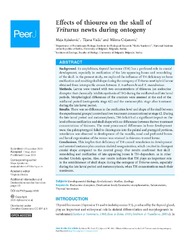Приказ основних података о документу
Effects of thiourea on the skull of Triturus newts during ontogeny
| dc.creator | Ajduković, Maja | |
| dc.creator | Vučić, Tijana | |
| dc.creator | Cvijanović, Milena | |
| dc.date.accessioned | 2021-06-22T08:42:56Z | |
| dc.date.available | 2021-06-22T08:42:56Z | |
| dc.date.issued | 2021 | |
| dc.identifier.issn | 2167-8359 | |
| dc.identifier.uri | https://radar.ibiss.bg.ac.rs/handle/123456789/4251 | |
| dc.description.abstract | Background In amphibians, thyroid hormone (TH) has a profound role in cranial development, especially in ossification of the late-appearing bones and remodeling of the skull. In the present study, we explored the influence of TH deficiency on bone ossification and resulting skull shape during the ontogeny of Triturus newt hybrid larvae obtained from interspecific crosses between T. ivanbureschi and T. macedonicus. Methods Larvae were treated with two concentrations of thiourea (an endocrine disruptor that chemically inhibits synthesis of TH) during the midlarval and late larval periods. Morphological differences of the cranium were assessed at the end of the midlarval period (ontogenetic stage 62) and the metamorphic stage after treatment during the late larval period. Results There was no difference in the ossification level and shape of the skull between the experimental groups (control and two treatment concentrations) at stage 62. During the late larval period and metamorphosis, TH deficit had a significant impact on the level of bone ossification and skull shape with no differences between the two treatment concentrations of thiourea. The most pronounced differences in bone development were: the palatopterygoid failed to disintegrate into the palatal and pterygoid portions, retardation was observed in development of the maxilla, nasal and prefrontal bones and larval organization of the vomer was retained in thiourea-treated larvae. Conclusions This implies that deficiency of TH caused retardation in development and arrested metamorphic cranium skeletal reorganization, which resulted in divergent cranial shape compared to the control group. Our results confirmed that skull remodeling and ossification of late-appearing bones is TH–dependent, as in other studied Urodela species. Also, our results indicate that TH plays an important role in the establishment of skull shape during the ontogeny of Triturus newts, especially during the late larval period and metamorphosis, when TH concentrations reach their maximum. | sr |
| dc.language.iso | en | sr |
| dc.publisher | London: PEERJ INC | sr |
| dc.relation | info:eu-repo/grantAgreement/MESTD/inst-2020/200007/RS// | sr |
| dc.relation | info:eu-repo/grantAgreement/MESTD/inst-2020/200178/RS// | sr |
| dc.rights | openAccess | sr |
| dc.rights.uri | https://creativecommons.org/licenses/by/4.0/ | |
| dc.source | PeerJ | sr |
| dc.subject | Endocrine disruptor | sr |
| dc.subject | Ossification level | sr |
| dc.subject | Geometric morphometric | sr |
| dc.subject | Salamanders | sr |
| dc.subject | Thyroid hormones | sr |
| dc.title | Effects of thiourea on the skull of Triturus newts during ontogeny | sr |
| dc.type | article | sr |
| dc.rights.license | BY | sr |
| dcterms.abstract | Aјдуковић, Маја; Вучић, Тијана; Цвијановић, Милена; | |
| dc.rights.holder | © 2021 Ajduković et al. | sr |
| dc.citation.volume | 9 | |
| dc.identifier.doi | 10.7717/peerj.11535 | |
| dc.identifier.pmid | 34141485 | |
| dc.identifier.scopus | 2-s2.0-85107477083 | |
| dc.identifier.wos | 000656972900009 | |
| dc.citation.apa | Ajduković, M., Vučić, T., & Cvijanović, M. (2021). Effects of thiourea on the skull of Triturus newts during ontogeny. PeerJ, 9, e11535. | |
| dc.citation.vancouver | Ajduković M, Vučić T, Cvijanović M. Effects of thiourea on the skull of Triturus newts during ontogeny. PeerJ. 2021;9:e11535. | |
| dc.citation.spage | e11535 | |
| dc.type.version | publishedVersion | sr |
| dc.identifier.fulltext | https://radar.ibiss.bg.ac.rs/bitstream/id/8530/peerj-11535.pdf | |
| dc.citation.rank | M22 |

